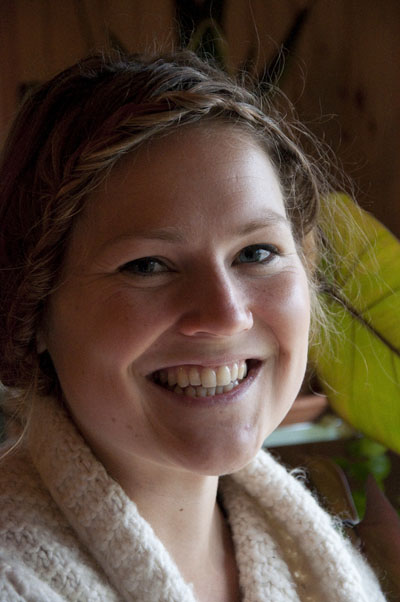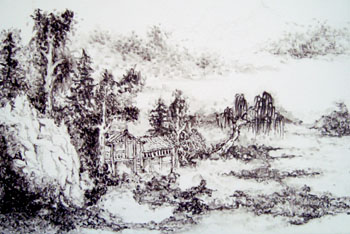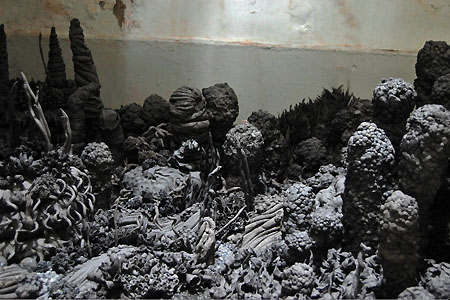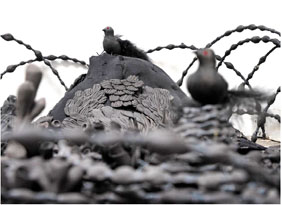IMPRESSIONS
FROM CHINA - CHARLOTTE NORDIN
by Michèle Vicat

CHARLOTTE NORDIN, photograph William
Dowell © 2010 |
Many
Chinese artists complain that their system of education is
overly focused on copying and reproducing artwork
until it reaches perfection. In contrast, young artists
from the West go to China for exactly that reason. They
are looking for discipline and a counterweight to the freedom
and
lack of
structure they encounter in many art schools in Europe and in
the USA.
Charlotte Nordin, a young Swedish ceramist, based in Switzerland,
went to China this summer to meet traditional ceramists in Tangshan
and Jingdezhen. Jingdezhen, known as China’s “Porcelain
Capital,” produced the royal porcelain for the Yuan, Ming
and Qing Dynasties. Limoges in France will create a ceramics
studio in the city of Jingdezhen in the spring of 2011. It is
also there that Ai Weiwei produced the millions “Sunflowers
Seeds,” the porcelain specks that recently caused all the
hubbub linked with the exhibition at the Tate Modern in London.
At 27, Charlotte Nordin has already won several awards, including
the prestigious Prix de la Relève at the 20th International
Biennale of Contemporary Ceramic of Vallauris (in the South of
France) for her installation Unknown Forest. Picasso
lived in Vallauris and produced most of his ceramics there. Charlotte
Nordin also received the Prix de la Ville de Nyon, Switzerland,
in November 2010.
We recently interviewed Charlotte Nordin in her new studio in
the town of Trélex, Switzerland. We were interested in
seeing how China had affected a promising new western talent
who wants to link the learning from the past to her future work
by crossing cultures.
What do you mean when you say that ceramic work is more than an
object?
To approach ceramics as an objet can be a very good thing at first.
When you have your first mass of clay in your hands and you put
it on the throwing wheel with your bare hands and you make a shape
out of it, it is quite emotional. Your reaction might be “Oh!
I just made a bowl!” Then you realize it is there because
of the dialogue between the clay and your hands. Your hands are
the expression of you but the clay has its own expression as well.
So, it always goes the way it feels it is going to. There are many
ways to use ceramics, but depending the way you use it, the way
you are modeling it, it does not have to be an object. It is something
that happens, that does not really belong to you; it is also the
way the clay is responding.

Les
Glands
de Vénus, porcelain,gilding,metal structure, photograph © Charlotte
Nordin |
Where did you get your taste for the earth?
I have been asking that question myself a lot. I went to different
art schools before I did ceramics. I did drawing, which I suppose
a lot of people do. I was always getting a little bored by it.
It was not that that makes me shiver, so to say. When I found ceramics,
I knew that was my material, there was no question about it.
Did some people influence you?
The
main influence is the clay itself. I remember what was said
to us in school about what has been done historically with
the clay. I was very attracted to what the Japanese were doing.
If
you make a comparison between what people do in China and in
Japan, the Chinese want to be the masters of the clay, they
want to make
it exactly the way they want it to go. They make such perfect
shapes and amazing glaze such as celadon, which is technically
perfect
and very complicated. The Japanese go in another direction.
They want the clay to have its own life. They have shapes that
are
not necessarily perfect. They have glazes that drip a little
bit. When
I learned the difference, I was more touched by this side of
the ceramics, “pas trop rangé” (not too
perfect), because I was pretty messy myself. But ceramics is
a very rigorous
technique as I realized later. The Chinese put a lot of attention
into one piece. This allows you to put your soul in one piece
also. It is a very general idea but from the impulsive way
of considering
ceramics and letting the clay live, I am now going into this
slow Chinese way of getting better.
Was this your main reason to go to China?
I did not think I would be so amazed before I went to China. The
main reason I went to China is that I feel that we have lost so
much of these old ways of looking at the material. No one really
teaches you in art schools here to look at the material, to see
it, to try to understand what it is telling you. I think that is
something I found in the old ways of working in China. I do not
know if this is what they are teaching to their students now, but
that was the way of the old masters. What I learned about the Chinese
way is that they repeat the same gestures as their predecessors
made before them. They know they are very humble and they also
become very humble about these gestures because they know that
art has everything to teach them. Here, in the West, we learn that
we should become a great artist; we have something to show to the
world. So, we have to come with something new. It kind of destroys
it, because you have to keep that in your mind. Of course, you
want to do new things and you want to take things that have been
done in the past and put a new layer on it, something more contemporary.
But, thinking that we are the masters and that we can forget everything
that has already been done is really not good.

Charlotte
Nordin's 10th repetition of a drawing in Gou Chun's studio,
Tangshang |

Gou
Chun, Charlotte's Master of Painting on Porcelain, Tangshang |
In China, students still learn a strict way of copying. They
acquire a very high level of technique, while in the West the
accent is
put on freedom and pure creativity. But, how do you get freedom
without technique? How do you develop technique without freedom?
It is interesting to see people like you going to China as
well
as Chinese artists coming to the West. A communication
starts…
I think that I would not like only to copy the old masters.
It would become very boring. But, I think it is something
not to completely
forget.
When I was in China, I met this old porcelain painter who
took me as a student for a little time. He wanted to teach
me these
old ways of painting on porcelain. Every day, I came back
and I did the same drawing again and again and again. At
the end
of the
day, he erased everything. I thought it was a great way of
teaching. He did not speak too much, just simple things like “too much
water.” The first time I did a drawing, I thought it
was not too bad! At the end, though it was not yet perfect,
I could
see a big difference between the first and the last drawing.
I mastered the lines better.

Removing jars from a kiln in Jingdezhen
photograph © Charlotte Nordin |
Did
you go to China to learn more about the technique or about
the essence of ceramics?
I was ready to say that it was about the essence, but technique
is important as well. I went to Tangshan (Province of Hebei)
and to Jingdezhen (Province of Jiangxi). When you go there,
you see
people only doing ceramics. It was fantastic to look at all
these shapes again, because I used to get bored about shapes
that are
used for daily purposes. I am so involved with installations.
I am not proud about the feeling I had, but I felt that these
were
people who did not realize that there was
anything different! In the end, I realized that I was the one
who was running too
fast;
there is so much more in the bowl.
My aim before was to transmit an emotion, to put as much
of my soul into my work so it can speak to the soul of
the person it
is talking to. I am not going away from that idea of
the soul, but the way you touch your material, the knowledge
you have about
your material, is also very important to take it a step
further.
One of my dreams is to go back to China for a longer
time and stay with an old master who can break down everything
I have learned
so far, who can bend it another way. I want to have a
broader
view.
How do you see the fusion between your previous installations and
what you experienced in China? Where do you feel you are right
now?
I must say that I have been very moved by this trip to China.
I find it is difficult to work my old ways again. Right
now, I am
working on a production of vases because I do not have
to think too much. It is vertiginous when you stand there and
you feel that
there is something big that is coming at you and will
spin
you around. It looks like I have to start all over again.
At the same
time, I do not have to be too dramatic about it. I have
to go step by step and see where it leads me.
One of the first things I realize is that I need a pottery
wheel! Because I need to go back to the basics. Not long
ago, I received
subsidies from a Swedish association of women abroad.
They gave me some money for a proposal I did to them. It
is a
big snake.
I am phobic about snakes. I thought I have to challenge
myself. My first idea was to do different pieces by hand
and paste
them together. But then, I realized I have to go to the
essence of the
snake. Making it with a wheel will make me go closer
to that idea. The snake has a vibrating movement. On the
wheel, I
can do cylinders
and give them a spin, so it has a rhythm. That is something
I have not done before.

Unknown Forest, black middle temperature firing clay, unglazed
photograph © Charlotte Nordin |
You never used a pottery wheel for your installations?
No. For instance Unknown Forest is composed of plants
that I invented by hand. It was a way of playing creator!
There
are so many mysterious
things that happen in the nature, there are phenomena
that we do not quite understand. I needed to create my
own forest
to understand
it better. That is the reason why I had to have it in
my hand as well. It was very impulsive. No glaze. It
was a very
quick way
of working.

coCON,
ceramic, moss, ivy, photograph © Charlotte Nordin |
Is
it the
same approach that you used with coCON?
I started to slow down there. It is a very repetitive
way of working. I did thousands of these little shapes.
I could
even do that in
my kitchen! It did not require a lot of attention. But
it was a great period to work like that, to have the
clay like
that, right
in your hands. It took me more than 5 months to do these
shapes. I was very calm at that time. We can put that
in relation with
the copy of the masters in a sense. You have to do the
same line and you have to put the vibration of life into
these
lines. I was
trying to put a little bit of life in each of these nodes.
This is what you meant before when you talked about the
intelligence of hands.
There are ways of creating. I have an idea. It
is very intuitive. Sometimes, it can be a word
that starts to
vibrate in my
head and I start building on that. There is more
information that comes
from that first feeling, or picture, or sound.
The conceptualization of the whole project will
take place afterwards. It is
interesting with ceramics, because you can finally
have a plan around
an idea. You touch the clay and, then, you realize
that it is not going
that way at all. The clay starts to lead you.
You have to be humble even if sometimes you get
mad because the
piece
cracks in the oven!
What was the purpose of the pieces you saw in China? Decoration,
practical, only for tourism? What is the level of ceramics you
saw there?
It is more interesting to talk about Jingdezhen. Because Tangshan
is very industrial. All the pieces you see with
the label “Made
in China” are done there. There are big
companies established there.
In Jingdezhen, everything is hand made. There
are pottery studios everywhere. I was walking
there
one day and
I saw four men
working on a big bowl. The manager of the studio
welcomed me, although
the craftsmen were not too happy, because they
see too many tourists. One of the craftsmen put
two big
piles
of clay,
one on top of
the other one, he centered it, he opened it and
here it was…a
bowl made in maybe 8 minutes. It is absolutely
crazy. But he repeated that with another bowl,
and another
one. In
one morning,
he did
20 bowls. No one in Europe has the skill to do
that. I do not know any one. I have a friend,
for instance,
he
lives in Bern
and he
is a traditional potter who works at traditional
burned potteries. They do not burn like that,
not like the
Chinese. We lost that,
because we do not have these big ceramics industries.
So, going to China was like seeing what happened
in Europe a long time
ago.
The big traditional jars are made in Jingdezhen.
They do the bottom, then the middle, and then
the top and
then they
put the parts together.
The tasks are often split. No wonder they become
perfect in what they do! It is a question of
repeating and repeating
over and over
again. The pieces produced in Jingdezhen are
sent all over the world.

Studio
for painting on porcelain in Tangshang, photograph
© Charlotte Nordin |
Do many westerners come to Jingdezhen to be behind the wheel?
It is happening. There is the Pottery Workshop, an artist
residency, which was created in 2005 by Caroline Cheng.
The main one is in
Jingdezhen. There is another one in Shanghai. She has a boutique
in Beijing too. This is a place where international artists come
to do clay, maybe for the first time, or because they have an
idea of a production they want to have made. I met a
Dutch girl there,
who spends 6 months in Jingdezhen, and then she goes back to
Holland where she promotes the work that was done in
China –not by
her but by a studio.
Are the Chinese worried that you copy them?
It is rather the opposite. People are afraid that the Chinese
copy them!
Most of the people are saying that the quality is going down
in China because it is becoming a mass production.

Birds'
Nest (detail), black middle-termperature firing clay, fired
iron, photograph © Alexis Voelin |
Have
you met younger Chinese ceramists moving in the direction
of contemporary art, doing installations for example?
There are still simple people who work there. The time
of the traditional masters is not over. The industry is
in China
and
as long they
can make money from it that is fine. I do not think that
people are loosing traditions in Asia. There are great
masters in
Japan and in Korea. Ceramics sticks in the ground in Asia
and in people’s
minds.
People were already collectors during the Ming Dynasty. Ceramics
is also linked with drinking tea. The cup is not simply a bowl.
It should be perfect to welcome the tea.
Absolutely and everyone I met in China is aware of that
notion. The bowl is an image for the universe. This is
something
that they all know. They have all sorts of clay with magical
names
like “Starry
Sky.” It is a great ceramics culture. If you say “porcelain,” people
do not know what you are talking about, but if you say “China
Clay”, they all know. The reference is there.
You arrived first in Beijing. What was your impression of the
city?
The first two days, I was a little bit shocked, I must say.
It is so different from what we use to see.
In what way?
The smell, the streets, the crowd, the people, I do not know.
Everything. The energies are different. It took me a little
time to adapt to
that. But, two days is not very long. Then, I started to look
at the city. Big avenues, a lot of cars, pollution. But after
a while,
I realized the charm of Beijing, because when you arrive you
do not see the hutongs and the temples. You see the gigantic
avenues
and the sky that is always grey.
You also visited the art area 798…
I was shocked to see the cheap art there. It can give people
a very bad impression of contemporary Chinese art. Like plastic
pandas.
I took some pictures of things I could not believe! These perfect
portraits of girls with big butterflies in the hair. To my
eyes, it was very kitschy. May be I should not look with my
eyes neither.
May be they are trying to find themselves too.
I think that as the situation is changing in China,
more and more people will need to find their humanity in
all
the chaos
around
them. So, the ones who have technique and tools will be
able to do something very interesting…
It won’t be easy, because they were taught not to
think for a very long time. And now, suddenly, people are
coming
to them
and telling them that they have to think.
From your trip to China, what did you get in terms of new visions,
new projects, besides the fact that you want to buy a pottery
wheel in order to get closer to the essence of the material?
I have a few ideas about where I want to go. Mainly, I know
which direction I want to go more than I know what I want
to do. I am
very thankful for the trip. It changes many things. There
is so much for us to learn from the teaching there, from the
ambiance
that is all over China. There are things I never thought
I would
be so moved by, so touched. To be honest, I did not know
at all what to expect, and all of a sudden this new world opens
up. China
is very far away from us. Since I am back home, I am reading
Chinese literature and books dealing with China. It is
opening
me up to
to that new world. It was a trip for one month, but it has not really stopped
yet. I think you get yellow fever.
It will take time for me to see where I am going from now on.
But, as someone
said once to me: “Do not worry, you are not a production machine.”